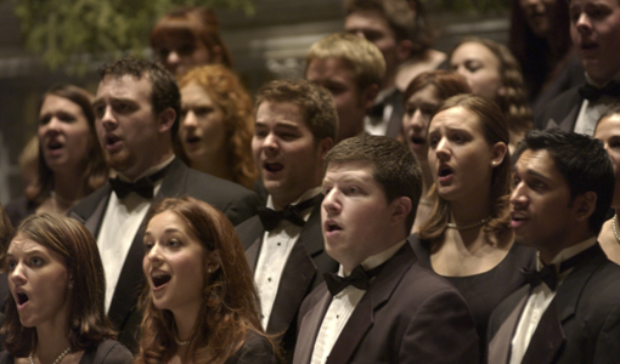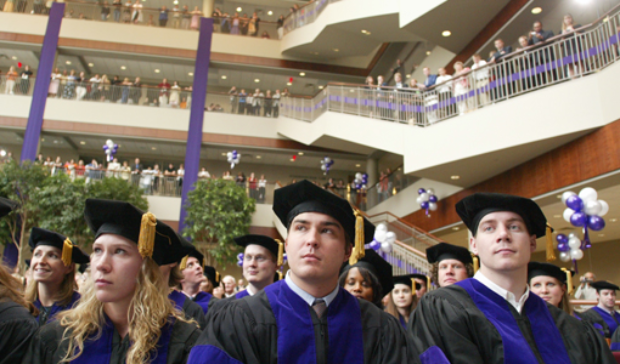“The St. Thomas Christmas concerts are a little taste of heaven,” said Rob Strusinski, who conducted the performances for many years. “There’s nothing like a good choir, they say, but in my estimation there’s no sound like a good singing congregation.”
And there is magic in those concerts, he maintains. “The audience or congregational hymns and carols have a stirring power and participation that in some magical way surpass the meticulously rehearsed and exquisitely performed choral pieces. The traditional opening Advent hymn used for many, many years – ‘Veni, Veni Emmanuel’ with brass choir, full organ and packed chapel – was a remarkable acclamation of Gregorian chant, and the thrilling traditional closing, ‘Hark the Herald,’ was goose-bump inducing.”
Now they pack the Chapel of St. Thomas for four concerts on a weekend early in December – nightly audiences of more than 500 alumni, friends and neighbors, about 200 singers from four choirs (Liturgical, Concert, Women’s and Chamber Singers) and up to 40 musicians (Handbell Choir, Brass and Guitar Ensembles), and sometimes professional musicians hired for specific instrumental needs.
Actually, the concerts began much more quietly in the early 1980s as Advent Vespers, Lessons and Carols. The vespers were a Liturgical Choir tradition that included Scripture readings of the season, Psalms, the Magnificat and the Lord’s Prayer alternated with choir and congregation hymns. Around 1990, the late Monsignor Terrence Murphy (president of St. Thomas from 1966 to 1991) requested that the Music Department produce its own Christmas concerts in the tradition of other area colleges.
Each concert has a theme, usually inspired by a single piece with additional music selected to reflect that theme and to focus on the intent of the concerts – being in Advent, preparing for the coming of Christmas. Themes have included Morning Star, Magnificat, Pacem in Terris, Voices of Angels, Voices of Hope, Jesu et Maria and Brilliant Light, Holy Night.
The music ranges from the classical sacred music of Bach, Mendelssohn and Mozart to music commissioned from contemporary composers such as St. Thomas’ Father Michael Joncas, to world music in native languages; some have featured African languages and African drums.
One of Strusinski’s favorites was the premiere of Dan Kantor’s “Night of Silence” at a concert in “two-part harmony, with simple piano, guitar, oboe and soprano solo. Later it was fully arranged for string orchestra and full choir, but somehow the simplicity of the original could not be matched.”
The theme for the 2005 concerts will be “All the Bells on Earth Shall Ring,” said Dr. Angela Broeker, Music Depart-ment, artistic director for the past four concerts who also directs the Concert Choir.
“In addition to the theme, we try to choose pieces that take our audiences from Advent to the Nativity and the Epiphany, so there is a story order in the way we arrange the pieces. Each concert also includes a Marian text that we sing during the Advent section,” Broeker said. “And there are always at least three congregational hymns.
“The choirs begin work on the repertoire in the regular rehearsals in September and October and often combine in November to rehearse numbers sung by the entire group. Dress rehearsals are only on the Wednesday and Thursday nights before the performances and often are open to the public.
“The students regard the concerts as a gift to the UST community. Though it is a tremendous amount of work in the week preceding finals, students give freely of their time. Upon graduation, it is participation in the Christmas concerts that choir alumni remember most fondly.”
And they laugh about the problems that sometime occur. Dr. Merritt Nequette, retired Music Department chair and associate academic dean, produced the concerts from 1994 to 2001. He recalls “enough snow one Friday to close the school and cancel the performance with theoretically every ticket good for the next sold-out night. Luckily, there was enough snow left to hold down Saturday’s crowd.”
Strusinski recalls the lovely effect of flickering candles and “one of the soprano’s hair briefly catching fire during a procession. She got a pretty good whack in the back of the head from the kid behind her.” His personal embarrassment was “marching to the podium to conduct, gesturing to the choirs to stand, and no one would get up. I thought it was mass mutiny, but I was out of order and it wasn’t my turn to conduct. The students always know what’s going on.”
“The concerts have become something special – the biggest event of the year for the performers,” Nequette said. “We always give them a free dinner Saturday for giving up their weekend.
“The concerts present a different, professional face of St. Thomas – the arts that are very much a part of the institution. They are well done. We do more composed music than most other schools and, yes, we are as good as St. Olaf, on which the concerts were somewhat modeled. We did move the concerts to St. Luke’s Church in St. Paul one year because of the crowds, but there was a definite feeling they should be on campus, in the chapel.”
A crowded chapel is a difficult aspect of the highly popular performances, explained Dr. Douglas Orzolek, Music Department, who now produces the concerts. “The members of our ensembles have reached such a size that we are not able to fit in any more performers. The concerts are tremendously popular and we prefer not to turn down ticket requests. More performances are not possible because of the hours our students are already putting in. We need a larger on-campus venue for the concerts as well as for our large performing bands and choirs that now often have to perform off campus.”
The concerts mean different things to different people. “Some view a concert as a spiritual event that reminds them of the reason for the season. Others perhaps attend to gather themselves before finals and the rush of the season. For many, it is their own tradition – the holidays begin when they attend the concerts,” Orzolek said.
“Music seems to say things that words alone cannot. Many people would argue that the greatest music is that traditionally heard at holidays. It’s not hard to imagine why. The music is filled with such joy, expectation, rebirth and heightened expression.”
The showcase of talent for the Music Department is a campus-wide activity supported by the entire community, from Campus Ministry to campus carpenters, said Nadine Friederichs, associate director of the Alumni Association, which coordinates concert details. “They are an annual tradition, and many alumni feel this is one of the greatest spiritual events sponsored by the university.”
And sometimes the music is very personal. “One year, we were snowbound and I contacted some Liturgical Choir kids and they called everyone living on campus,” Strusinski recalled. “We met in the chapel at the time the concert was supposed to start, just to get a chance at another rehearsal.
“I’ll always remember that there was one elderly man, a neighbor, who walked over from Goodrich Avenue, “I’ll always remember that there was one elderly man, a neighbor, who walked over from Goodrich Avenue, not knowing the concert was canceled. We gave him a command performance. I’ll never forget him sitting in the front row, crying. It was very moving.”







